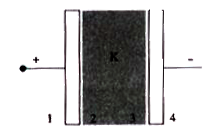Explain dielectric constant with expressions.
Step-by-Step Solution:
1. Definition of Dielectric Constant:
The dielectric constant, often denoted by k, is a measure of a material's ability to store electrical energy in an electric field. It is a dimensionless quantity that indicates how much electric flux a material can hold compared to a vacuum.
2. Expression for Dielectric Constant:
The dielectric constant is defined mathematically as the ratio of the permittivity of the medium (ϵ) to the permittivity of free space (ϵ0):
k=ϵϵ0
Where:
- k = Dielectric constant
- ϵ = Permittivity of the medium
- ϵ0 = Permittivity of free space (vacuum)
3. Understanding Permittivity:
- Permittivity of Free Space (ϵ0): This is a constant that represents the ability of a vacuum to permit electric field lines. Its value is approximately 8.854×10−12F/m.
- Permittivity of a Medium (ϵ): This value depends on the material and indicates how much electric field is reduced within the material compared to a vacuum.
4. Significance of Dielectric Constant:
The dielectric constant indicates how much the electric field is reduced in a material compared to the vacuum. A higher dielectric constant means that the material can store more electric energy.
5. Unitless Nature:
Since the dielectric constant is a ratio of two permittivities, it is unitless and dimensionless. Its value is always greater than or equal to 1, as the permittivity of any material cannot be less than that of free space.
The dielectric constant, often denoted by k, is a measure of a material's ability to store electrical energy in an electric field. It is a dimensionless quantity that indicates how much electric flux a material can hold compared to a vacuum.
The dielectric constant is defined mathematically as the ratio of the permittivity of the medium (ϵ) to the permittivity of free space (ϵ0):
k=ϵϵ0
Where:
- k = Dielectric constant
- ϵ = Permittivity of the medium
- ϵ0 = Permittivity of free space (vacuum)
- Permittivity of Free Space (ϵ0): This is a constant that represents the ability of a vacuum to permit electric field lines. Its value is approximately 8.854×10−12F/m.
- Permittivity of a Medium (ϵ): This value depends on the material and indicates how much electric field is reduced within the material compared to a vacuum.
The dielectric constant indicates how much the electric field is reduced in a material compared to the vacuum. A higher dielectric constant means that the material can store more electric energy.
Since the dielectric constant is a ratio of two permittivities, it is unitless and dimensionless. Its value is always greater than or equal to 1, as the permittivity of any material cannot be less than that of free space.
Similar Questions
Dielectric constant has the same dimensions
View SolutionWhat is potential at a distance r(<R) in a dielectric sphere of uniform charge density ρ, radius R and dielectric constant εr.
View SolutionExplain the term cell constant.
View SolutionThe two square faces of a rectangular dielectric slab (dielectric constant4.0) of dimensions 20cm x20cm x 1.0mm are metal -coated. Find the capacitance between the coated surfaces.
View SolutionAn isolated capacitor of capacitance C is charged to a potential V. Then a dielectric slab of dielectric constant K is inserted as shown. The net charge on four surfaces 1,2, 3 and 4 would be respectively.

View SolutionThe velocity factor of a transmission line is 0.62 .Calculate dielectric constant of the insulation used.
View SolutionDielectric constant has the same dimensions as
View SolutionCorrect ORDER of acidity & dielectric constant is
View Solution
Cp ( without dielectric ) = 2C
CQ ( without dielectric ) = C
k and 2 k are dielectric constant of two dielectrics . Find resultant capacity between A and B .
View SolutionA parallel plate capacitor has a dielectric (of dielectric constant k) between the plates. The plates are charged to a surface charge density σ0. What is the density of the polarized charge that appear on the surface of the dielectric.
View Solution
